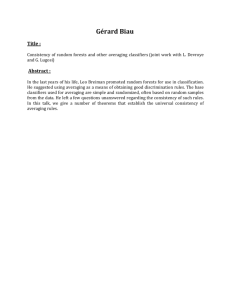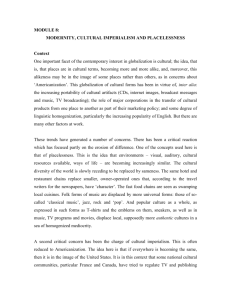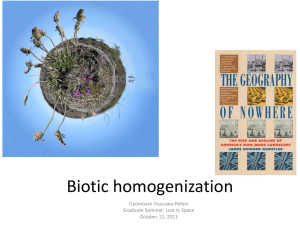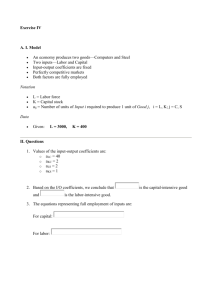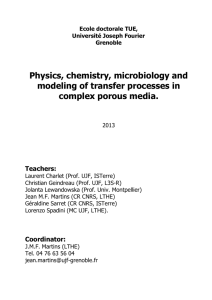R.Khasminskii Department of Mathematics, Wayne State University
advertisement
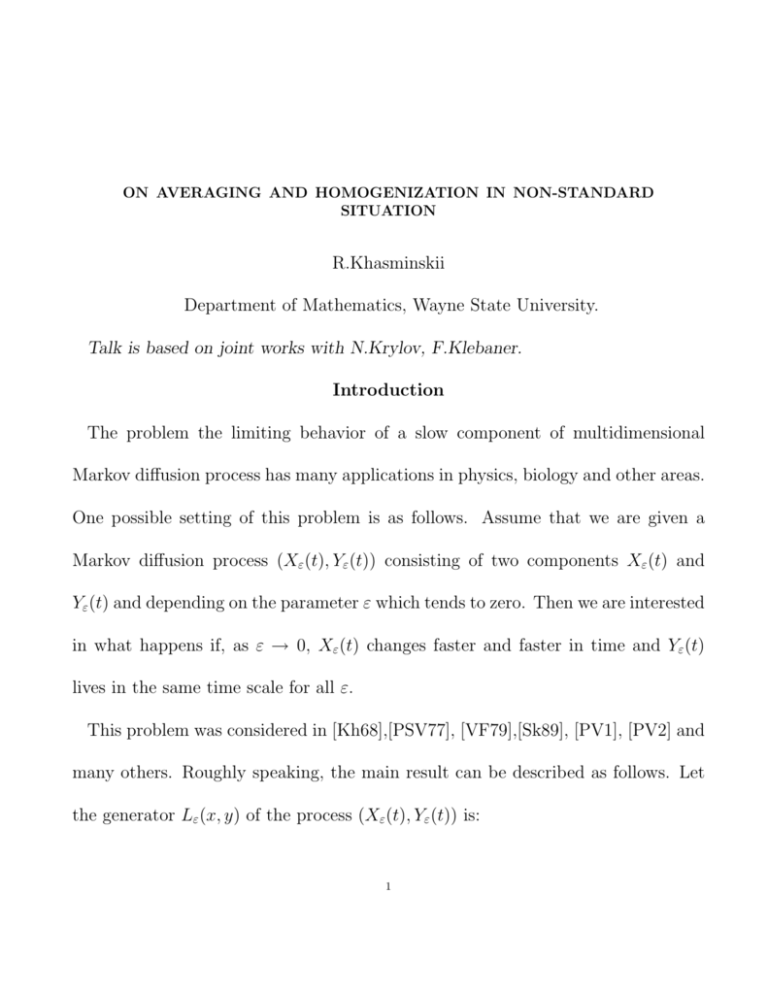
ON AVERAGING AND HOMOGENIZATION IN NON-STANDARD
SITUATION
R.Khasminskii
Department of Mathematics, Wayne State University.
Talk is based on joint works with N.Krylov, F.Klebaner.
Introduction
The problem the limiting behavior of a slow component of multidimensional
Markov diffusion process has many applications in physics, biology and other areas.
One possible setting of this problem is as follows. Assume that we are given a
Markov diffusion process (Xε (t), Yε (t)) consisting of two components Xε (t) and
Yε (t) and depending on the parameter ε which tends to zero. Then we are interested
in what happens if, as ε → 0, Xε (t) changes faster and faster in time and Yε (t)
lives in the same time scale for all ε.
This problem was considered in [Kh68],[PSV77], [VF79],[Sk89], [PV1], [PV2] and
many others. Roughly speaking, the main result can be described as follows. Let
the generator Lε (x, y) of the process (Xε (t), Yε (t)) is:
1
2
ON AVERAGING AND HOMOGENIZATION IN NON-STANDARD SITUATION
Lε (x, y) = ε−2 L1 (x, y) + ε−1 L2 (x, y) + L3 (x, y),
L1 (x, y) =
l1
X
1
X
∂2
∂
(1)
+
bi (x, y)
,
∂xi ∂xj
∂x
i
i=1
l
(1)
aij (x, y)
i,j=1
L2 (x, y) =
l2
l1 X
X
i=1 j=1
L3 (x, y) =
l2
X
(2)
aij (x, y)
∂2
,
∂xi ∂yj
2
X
∂2
∂
(3)
+
bi (x, y)
.
∂yi ∂yj
∂y
i
i=1
l
(3)
aij (x, y)
i,j=1
Suppose that, for any fixed y, the Markov process X x,y (t) with generator L1 (x, y)
and satisfying X x,y (0) = x is ergodic. Assume the density of its stationary distribution exists and denote it by ρ(x, y). Denote also for any function g(x, y)
Z
ḡ(y) =
g(x, y)ρ(x, y)dx
and let Ȳ y (t) be the Markov process starting at y with generator L̄3 . Under some
additional conditions on the coefficients, guaranteeing, in particular, compactness
of the family of measures generated by Yεx,y (t) for ε → 0 and weak uniqueness
of the process Ȳ y (t), the averaging principle for the slow component was proved:
distr
Yεx,y (t) −→ Ȳ y (t) for any x, y, as ε → 0.
ON AVERAGING AND HOMOGENIZATION IN NON-STANDARD SITUATION
3
The related result also can be formulated in the PDE terms, making use of the
probabilistic representation for the solution of Cauchy problem for parabolic PDE’s.
Let uε (t, x, y), x ∈ Rl1 , y ∈ Rl2 , be a solution of the problem
∂uε
= Lε (x, y)uε + c(x, y)uε + f (x, y); uε (0, x, y) = φ(x, y).
∂t
(1)
Assume that coefficients of the operator L1 have the property: for any fixed y the
problem
L∗1 (x, y)ρ(x, y) = 0;
Z
ρ(x, y)dx = 1
(2)
Rl1
has a unique solution. (Sufficient conditions on coefficients for this property are
(k)
(k)
well known, see, e.g., [PV1]). Assume also that all coefficients aij , bi are bounded
and smooth enough . Then uε (t, x, y) → ū(t, y), as ε → 0, here ū(t, y) is a solution
of the problem (see, e.g., [KY])
∂ ū
= L̄3 (y)ū(t, y) + c̄(y)ū + f¯(y); ū(0, y) = φ̄(y).
∂t
(3)
Question: what is the limit behavior of uε if the fast component is not ergodic? In
what follows we restrict ourself by the one-dimensional fast component, l1 = 1. The
fast component can be transient or null-recurrent. For the transient fast component
the limit of uε (t, x, y) can depend on the fast component x.
4
ON AVERAGING AND HOMOGENIZATION IN NON-STANDARD SITUATION
Assume, for instance, that the fast component can go to +∞ and to −∞ with
±
positive probability, and L3 (x, y) → L±
3 (y), φ(x, y) → φ (y) as x → ±∞, and
L2 (x, y) = 0. Then it is not hard to prove that a solution uε (t, x, y) of the problem
∂uε
= Lε (x, y)uε ; uε (0, x, y) = φ(x, y),
∂t
has the following limiting behavior: for t > δ > 0
lim uε (t, x, y) = p(x, y)u+ (t, y) + (1 − p(x, y))u− (t, y),
ε→0
here the function p(x, y) is a solution of the problem
L1 (x, y)p(x, y) = 0; p(−∞, y) = 0, p(+∞, y) = 1
( it can be written at the explicit form) and u± (t, y) is a solution of the problem
∂u±
±
±
±
= L±
3 (y)u ; u (0, y) = φ (y).
∂t
ON AVERAGING AND HOMOGENIZATION IN NON-STANDARD SITUATION
5
Averaging for null-recurrent fast component
The simplest case of the null-recurrent one-dimensional fast component is the
(1)
2
∂
case where L1 (x, y) = a11 (x, y) ∂x
2 with
(1)
0 < c1 ≤ a11 (x, y) ≤ c2 < ∞.
(4)
Thus we have considered in [KK] the diffusion process with two scales and generator
X
∂2
∂2
Lε (x, y) = ε a00 (x, y) 2 + 2ε−1
ai0 (x, y)
∂x
∂x∂yi
i=1
d
−2
d
X
X
∂2
∂
+
aij (x, y)
+
bi (x, y)
∂yi ∂yj
∂yi
i,j=1
i=1
d
(5)
:= ε−2 L1 (x, y) + ε−1 L2 (x, y) + L3 (x, y)
We suppose that the following conditions concerning the coefficients of (5) are valid.
A1. The coefficients aij , bi are Lipschitz continuous in (x, y) and, for each x,
their derivatives in y up to and including second order derivatives are bounded
continuous functions of y.
A2. For some positive constants c1 , c2 the condition (4) is valid and for some
constant c3 > 0
d
X
i=1
(aii (x, y) + b2i (x, y)) ≤ c3 (1 + |y|2 ).
6
ON AVERAGING AND HOMOGENIZATION IN NON-STANDARD SITUATION
We denote below p(x, y) = (a00 (x, y))−1 .
B1. The function p(x, y) has a limit p± (y) in C̀esaro sense, as x → ±∞:
lim x
−1
Z
x→±∞
x
p(z, y)dz = p± (y)
0
uniformly in y ∈ Rd and, moreover, also uniformly in y ∈ Rd ,
lim x
−1
Z
x→±∞
lim x
x→±∞
x
0
−1
Z
x
0
∂p± (y)
∂p(z, y)
dz =
,
∂y
∂y
∂ 2 p± (y)
∂ 2 p(t, y)
dt =
.
∂y 2
∂y 2
We suppose further that the coefficients aij (x, y), bi (x, y), i = 1, ..., d, j = 0, ..., d
and all their derivatives in y up to the second order also have averages in x, as
x → ±∞ with the weight p(x, y). To write these conditions in a compact form
we use the following notation: for any function K(x, y) having the limit in C̀esaro
sense as x → ±∞,
+
K (y) := lim x
−1
x→+∞
−
K (y) := lim x
x→−∞
Z
x
K(t, y)dt,
0
−1
Z
x
K(t, y)dt;
0
K ± (x, y) := K + (y)1{x>0} + K − (y)1{x≤0} .
ON AVERAGING AND HOMOGENIZATION IN NON-STANDARD SITUATION
7
For a function K(x, y) we write K ∈ K if K ± exists and
x
−1
Z
x
K(z, y)dz − K ± (x, y) = (1 + |y|2 )α(x, y).
0
Here ( and below) the function α is bounded and satisfies
lim sup |α(x, y)| = 0.
|x|→∞ y∈Rd
B2. For i = 1, ..., d, j = 0, ..., d, we have
pbi , Dy (pbi ), Dy2 (pbi ), paij , Dy (paij ), Dy2 (paij ) ∈ K.
Introduce also the notations
(aij p)± (x, y)
,
āij (x, y) =
p± (x, y)
(bp)± (x, y)
b̄(x, y) = ±
; Ā(x, y) = (āij (x, y))i,j=0,1,...,d .
p (x, y)
Observe, in passing, that ā00 (x, y) = (p± (x, y))−1 .
Consider the Markov diffusion process Z̃(t) = (X̃0 (t), Ỹ0 (t)) with the diffusion
matrix Ā(x, y) and the drift vector (0, b̄(x, y))∗ and denote L̄(x, y) the generator of
this process.
It is proven in [KK] that the slow component only does not converge to any
limiting process, but the pair (εXε (t), Yε (t)) converges weakly to the limit Z̃(t) if
the diffusion matrix Ā(x, y), the drift vector (0, b̄(x, y))∗ and the initial conditions
8
ON AVERAGING AND HOMOGENIZATION IN NON-STANDARD SITUATION
determine the distribution of Z̃(t) uniquely. These coefficients are smooth functions
only in each half-space {x > 0} and {x < 0} and can have jumps at the hyperplane
x = 0. This circumstance makes not self-evident the uniqueness of the process
with this generator, which is essential for our approach. We have considered in
[KK] some examples where this uniqueness has place, and, in general, added this
uniqueness condition to our Theorem. But recently Krylov found in [Kr 03] that
the weak uniqueness for the solution of the appropriate SDE’s and PDE’s always
has place under conditions A, B. The generator of Z̃ε (t) is
L1 (x/ε, y) + L2 (x/ε, y) + L3 (x/ε, y) = L(x/ε, y)
In PDE’s terms the result can be formulated by the following way.
Theorem 1. Let the conditions A, B be fulfilled and c(x, y) ∈ K, f (x, y) ∈ K.
Denote
c̄(x, y) =
(pc)± (x,y)
p± (x,y) ;
f¯(x, y) =
(pf )± (x,y)
p± (x,y) ;
L̄(x, y) =
(pL)± (x,y)
p± (x,y) .
solution of the Cauchy problem
∂uε
∂t
= L(x/ε, y)uε + c(x/ε, y)uε + f (x/ε, y); uε (0, x, y) = ϕ(x, y) (6)
converges, as ε → 0, to the unique bounded solution
2,1
ū(x, y, t) ∈ Wd+1,loc
of the problem
∂ ū
∂t
= L̄(x, y)ū + c̄(x, y)ū + f¯(x, y); ū(0, x, y) = ϕ(x, y).
(7)
Then the
ON AVERAGING AND HOMOGENIZATION IN NON-STANDARD SITUATION
9
The natural question: is it possible to include the case of initial conditions also
depending on x/ε?
Corollary 1. Let the conditions of the Theorem 1 be valid and ϕ(x, y) ∈ K also.
Denote ϕ̄(x, y) =
∂uε
∂t
(ϕp)± (x,y)
p± (x,y) .
Then the solution of the Cauchy problem
= L(x/ε, y)uε + c(x/ε, y)uε + f (x/ε, y); uε (0, x, y) = ϕ(x/ε, y) (8)
converges for t > δ > 0, as ε → 0, to the unique bounded solution
2,1
ū(x, y, t) ∈ Wd+1,loc
of the problem
∂ ū
∂t
= L̄(x, y)ū + c̄(x, y)ū + f¯(x, y); ū(0, x, y) = ϕ̄(x, y).
(9)
The proof of this Corollary can be obtained by combining the probabilistic approach of [KK] and the known results about Hölder continuity the solution of
parabolic equations with bounded coefficients for t > δ > 0 (see [Kr85]).
10
ON AVERAGING AND HOMOGENIZATION IN NON-STANDARD SITUATION
Homogenization
Homogenization problems for parabolic PDE were considered in many publications, see, for instance, [F], [PSV], [JKO], [BLP] and references there. It is supposed
in the most part of these references that the coefficients of the PDE are periodic
in all space variables. Now we first answer the question: what result concerning
homogenization follows from the Theorem 1 and Corollary?
Consider the Cauchy problem for the parabolic PDE
∂uε
∂ 2 uε
= a00 (x/ε) 2 + c(x/ε)uε + f (x/ε);
∂t
∂x
uε (0, x) = φ(x/ε). (10)
Assume that c1 ≤ a00 (x) = p−1 (x) ≤ c2 (c1 > 0), a00 (x) has two bounded derivatives, and the function p(x) has limits p± in C̀esaro sense, as x → ±∞.
Assume also that the functions p(x)c(x), p(x)f (x), p(x)ϕ(x) also have limits in
C̀esaro sense, as x → ±∞. Then all conditions of the Corollary are fulfilled for
the problem (10), and one can deduce from the Corollary that uε (t, x) → ū(t, x),
as ε → 0, here ū(t, x) is a solution of the problem
∂ ū
∂t
2
= ā(x) ∂∂xū2 + c̄(x) + f¯(x);
Here ā(x) = 1/p± (x),
ū(0, x) = ϕ̄(x).
c̄(x) =
(pc)± (x)
p± (x) ,
f¯(x) =
(pf )± (x)
p± (x) ,
ϕ̄(x) =
(pϕ)± (x)
p± (x) .
ON AVERAGING AND HOMOGENIZATION IN NON-STANDARD SITUATION
11
A natural question arises: is it possible to use the Theorem 1 for justification
the homogenization to the parabolic equations on R+ × R1 with the drift term? In
other words, can we apply the Theorem 1 for the analysis of the limiting behavior
of the equation
∂uε
∂t
2
ε
= a00 (x/ε) ∂∂xu2ε + b0 (x/ε) ∂u
∂x + c(x/ε)uε + f (x/ε);
uε (0, x) = φ(x/ε)? (11)
Unfortunately, the answer to this question is negative: the equation of the ’fast’
component in the Theorem 1 does not have a drift term. Nevertheless, it is well
known, that for the case periodic coefficients homogenization has place .
It was noticed in [KhKl] that the Theorem 1 can be generalized by the following
way. Instead of the process with the generator
∂
−1
Lε (x, y) = ε−2 a00 (x, y) ∂x
2 + 2ε
2
+
Pd
2
∂
i=1 ai0 (x, y) ∂x∂yi +
Pd
2
∂
i,j=1 aij (x, y) ∂yi ∂yj
Pd
∂
i=1 bi (x, y) ∂yi
the averaging principle can be justified for the process Ẑε (t) = (X̂ε (t), Ŷε (t)) with
the generator
∂
∂
−1
L̂ε (x, y) = ε−2 a00 (x, y) ∂x
b0 (x, y) ∂x
+ 2ε−1
2 + ε
2
+
Pd
2
∂
i,j=1 aij (x, y) ∂yi ∂yj +
Pd
∂
i=1 bi (x, y) ∂yi .
(12)
Pd
2
∂
i=1 ai0 (x, y) ∂x∂yi
12
ON AVERAGING AND HOMOGENIZATION IN NON-STANDARD SITUATION
Remark 1. Due to the presence the drift term b0 in (11) the process X̃ε (t) with
∂
∂
−1
the generator ε−2 a00 (x, y) ∂x
b0 (x, y) ∂x
with fixed y can be not necessarily null2 +ε
2
recurrent, as in [KK], but, may be, positive recurrent or transient. Nevertheless,
the averaging result in the theorem below is of the same type as for the process
with null-recurrent fast component (as in [KK]) due to the fact that the drift term
in this operator is small in comparison with the diffusion term.
We use here and below the same notations and assumptions concerning coefficients of the operator L̂ε (x, y) as above. There are only the following differences.
We include b0 in the smoothness condition A.1, the summation in the condition A.2
starts from i = 0, and assume, in addition, that pb0 ∈ K in the condition B.2.
Denote by Ã, B̃ the modified by this way conditions A, B.
(1)
As before , we consider the limiting behavior of the process Zε (t) = (εX̂ε (t), Ŷε (t)).
(1)
It is easy to see from (9) that the generator of the process Zε (t) has the form
2
∂
∂
L(1) (x/ε, y) = a00 (x/ε, y) ∂x
2 + b0 (x/ε, y) ∂x + 2
+
Pd
2
∂
i,j=1 aij (x/ε, y) ∂yi ∂yj +
Pd
∂
i=1 bi (x/ε, y) ∂yi .
Pd
∂2
i=1 ai0 (x/ε, y) ∂x∂yi
(12)
ON AVERAGING AND HOMOGENIZATION IN NON-STANDARD SITUATION
13
Introduce also the differential operator
2
∂
∂
L̄(1) (x, y) = ā00 (x, y) ∂x
2 + b̄0 (x, y) ∂x + 2
+
Pd
2
∂
i,j=1 āij (x, y) ∂yi ∂yj +
Pd
∂
i=1 b̄i (x, y) ∂yi .
Pd
∂2
i=1 āi0 (x, y) ∂x∂yi
(13)
Theorem 2.Let the conditions of Theorem 1 with replacement the conditions A,
B by Ã, B̃ are valid. Then solution of the Cauchy problem
∂uε
∂t
= L(1) (x/ε, y)uε + c(x/ε, y)uε + f (x/ε, y); uε (0, x, y) = ϕ(x/ε, y) (14)
converges, as ε → 0, to the unique bounded solution
2,1
ū(x, y, t) ∈ Wd+1,loc
of the problem
∂ ū
∂t
= L̄(1) (x, y)ū + c̄(x, y)ū + f¯(x, y); ū(0, x, y) = ϕ̄(x, y).
(15)
Consider now the Cauchy problem for the one-dimensional parabolic PDE
∂ 2 vε
∂vε
∂vε
= a(x/ε) 2 + b(x/ε)
+ c(x/ε)vε + f (x/ε); vε (0, x) = φ(x/ε).(16)
∂t
∂x
∂x
The next corollary follows from this theorem.
Corollary 2. Assume that the coefficients of (16) are Lipschitz continuous, a(x)
lies between two positive constants, and the functions
1/a(x) = p(x), b(x)p(x), c(x)p(x), f (x)p(x), ϕ(x)p(x) are bounded and have limits
p± (x), (bp)± (x), (cp)± (x), (f p)± (x), (ϕp)±) in C̀esaro sense, as x → ±∞. Then
the solution vε (t, x) of the problem (16) converges, as ε → 0, to the solution of the
14
ON AVERAGING AND HOMOGENIZATION IN NON-STANDARD SITUATION
problem
∂v0
∂ 2 v0
∂v0
= ā(x) 2 + b̄(x)
+ c̄(x)v0 + f¯(x);
∂t
∂x
∂x
v0 (0, x) = ϕ̄(x)
(17)
(18)
Here, as before, ā(x) = 1/p− 1{x<0} + 1/p+ 1{x≥0} , b̄(x) =
(pb)−
p− 1{x<0}
+
(pb)+
p+ 1{x≥0}
and the functions c̄(x), f¯(x), ϕ̄(x) are defined analogously.
Remark 2. The coefficients and the initial condition for the problem (17, (18)
are constants in each half-plane {x < 0} and {x > 0}. This circumstance allows to
write the solution of this problem explicitly.
Remark 3. For the special case p+ = p− , (pb)+ = (pb)− and so on this result
generalizes the homogenization result for the parabolic equations in R+ × R1 with
periodic or almost periodic coefficients. (See, e.g., [F], [BLP])
ON AVERAGING AND HOMOGENIZATION IN NON-STANDARD SITUATION
15
References
[BLP] Bensoussan A., Lions J.-L., Papanicolaou G.,1978, Asymptotic analysis for
periodic structures, Studies in Mathematics and applications,5,N.-Holland Publication Co., Amsterdam, 700 pp.
[F] Freidlin M. 1964, The Dirichlet problem for an equation with periodic coefficients depending on a small parameter. (Russian) Theory probability and its
applications,9, 133-139.
[F V] Freidlin M., Wentzell A., 1979, Random Perturbations of Dynamical Systems; Second edition,1998, Springer.
[JKO] Jikov V., Kozlov S., Oleinik O. 1994,Homogenization of differential operators and integral functionals, Springer, 570pp.
[Kh68] Khasminskii R., 1968, On averaging principle for Itô stochastic differential
equations, (in Russian) Kybernetika (Chechoslovakia), 4, 3, 260-279.
[KK] Khasminskii, R.; Krylov, N. On averaging principle for diffusion processes
with null-recurrent fast component. Stochastic Process. Appl. 93 (2001), no. 2,
229–240.
16
ON AVERAGING AND HOMOGENIZATION IN NON-STANDARD SITUATION
[KhKl] Khasminskii, R., Klebaner, F. 2003, A note on averaging and homogenization,Stochastics and Dynamics, 3,113-120.
[KY] Khasminskii,R., Yin, G. On averaging principles: an asymptotic expansions
approach, SIAM J.Math.Anal.,35,6, pp.1534-1560.
[K03] Krylov N. On weak uniqueness for some diffusions with discontinuous coefficients, submitted to Stochastic Process. Appl., 2003.
[K85] Krylov, N. Nonlinear elliptic and parabolic equations of the second order,
Kluwer, 1987.
[PSV] Papanicolaou G. C., Stroock D., Varadhan S.R.. 1977, Martingale approach to some limit theorems, Duke Univ. Math. Series III , 1-116.
[PV1] Pardoux E., Veretennikov A.,2001, On Poisson equation and diffusion approximation, I, Ann.of Probab. 29,1061-1085.
[PV2] Pardoux E., Veretennikov A.,2003, On Poisson equation and diffusion approximation, II, Ann.of Probab. 31,1166-1192.
[Sk] Skorokhod A., 1989, Asymptotic Methods in the Theory of Stochastic Differential Equations, AMS, Translations of Math. Monographs, 78.
